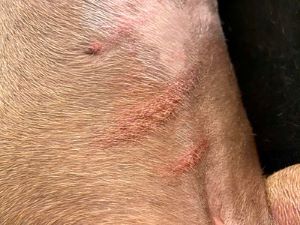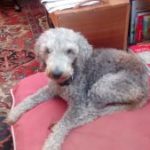
Many dog owners sitting down for a quick belly-rubbing session with their pooch are baffled to discover scabs or crusts on or around their pet’s nipples.
What’s wrong with my dog?
Is it something serious?
There are many reasons why a dog might have scabs on their nipples.
Some of them are really no cause for alarm and you’ll find many vets quickly dismissing any concerns, but, on the other hand, those black scabs might indicate a serious problem.
Let’s have a look at the most common causes that can lead to scabs and crusts forming on a dog’s nipples.
What you will learn from this article
- What is mastitis?
- Phantom pregnancy in dogs
- Six causes of black gunk or dried blood around nipples?
- How to relieve a dog’s itchy skin?
- Closing thoughts
What is mastitis?
For female dogs, most problems involving the nipples appear in the postpartum period.
If your dog has recently given birth, she might have mastitis, an inflammation of the teats usually caused by an accumulation of milk in the mammary glands or by a fungal or bacterial infection.
The most common signs of mastitis include:
- Swollen or inflamed mammary glands
- Discolored nipples
- Pain and discomfort
- Ulcerations
- Open wounds and scabs
The dog’s teats can become inflamed after the death of one or more puppies, which leads to less demand for milk.
At the same time, the mammary glands can become swollen if the puppies are removed prematurely from their mother.
Another common problem is puppies biting at their mother’s teats.
It’s not that the puppies are aggressive, they’re simply immature or they fight among themselves to get to the milk and involuntarily bite her teats.
The smallest wound can easily get infected, which explains both the scabs and the smelly discharge from a festering wound.
Escherichia coli (E. coli), Staphylococci, and β-hemolytic Streptococci are the most common bacteria involved in mastitis.
Mastitis requires immediate medical treatment, usually involving antibiotics.
In severe cases, the dog might need to be hospitalized to receive intravenous fluids and drugs.
Also, in some cases, the vet might recommend surgery to remove necrotic tissue.
Also, the puppies should not be allowed to nurse from the affected teats as they might get infected, too.
The owners should bottle-feed the puppies while the mother recuperates.
Phantom pregnancy in dogs
False pregnancies can also lead to mammary glands discharge, which makes the nipples prone to infections.
Typically, false pregnancy symptoms occur a few weeks after a heat cycle.
Even if the dog is not pregnant, the body behaves as if it were.
First of all, you might notice your dog manifesting typical nesting behavior.
As the body produces high levels of progesterone, the mammary glands will become enlarged and you might notice a whitish discharge. As the swollen teats will cause a bit of discomfort, the dog might scratch her nipples or lick those she can reach, which can lead to open wounds and infection.
In most cases, phantom pregnancy symptoms subside in two or three weeks and there’s no need for treatment.
However, you should check your dog’s nipples for signs of mastitis.
Expressing the milk is not recommended as this will only lead to the production of even more milk.
The vet might prescribe diuretics to help reduce milk production.
Six causes of black gunk or dried blood around nipples?
While problems with a nursing bitch are to be expected, many dog owners are very concerned when they discover ‘black gunk’ or even dried blood around their spayed or male pets.
This is a very common problem in dogs and here are some of the main causes.
Yeast infection
If your dog has recurrent yeast infections, it’s possible that this will affect one or more of the nipples. Yeast infections are caused by a fungus that proliferates in moist and hot areas of the body, especially skin folds. Yeast infections are usually associated with oily hair and skin, and they cause intense itchiness.
If your dog has got a yeast infection in or around a nipple, all that scratching will cause crusts and scabs.
Look for signs of yeast infection anywhere else on the dog’s body, such as:
- Sticky yellow or green discharge from open sores
- Greasy coat and oily skin
- Crusty flaky skin
- Musty odor
- Thickened ‘elephant’ skin
- Recurrent ear infections
The first line of treatment for yeast infections is using a special antifungal shampoo and making sure the product stays on the fur for at least ten minutes. Also, the vet might recommend antifungal oral medication if the dog has extensive skin issues.
Infected inverted nipples
A dog having inverted nipples is quite common and normally they shouldn’t cause him any problems at all. In dogs with long hair, the nipples are usually hidden by the fur and the owner might never even notice if they’re inverted. However, flat or inward-pointing nipples are an ideal ground for dirt accumulation. Also, the dog’s inverted nipples might get caked in sebum, the waxy substance produced by the sebaceous glands. In most cases, inverted nipples don’t bother a dog one bit, but if your pet scratches at them he might get crusts.
The best thing to do is give the dog a bath and gently clean the dirt around the nipples. If there are any signs of infection, apply an antibiotic gel.
Allergies and itching
Sometimes, the crusts you see on your dog’s nipples are caused by intensive scratching, if your pet has some type of allergy. Dogs can be allergic to food, pollen, dust, mold, insect bites or chemicals used around the house. Skin rashes or insect bite wounds can be extremely annoying, making the dog scratch furiously. Since the nipple area is very sensitive, it can easily lead to infections and scabbing.
In such cases, you should try to identify the allergen that’s causing your dog such misery and try to remove it from his environment. As for the wounds themselves, an antibiotic gel will probably get rid of the infection. Also, the dog might need soothing baths to relieve irritation and some calming ointment.
Abscess
If the dog has sustained some type of injury to the nipple, it can easily get infected by bacteria or fungi entering the milk ducts. An abscess is characterized by swelling and inflammation and pus leaking from the nipple. An abscess might appear around a wound caused by a puncture or scratch with a foreign body, such as a thorn or a twig. When the puncture wound closes it might trap bacteria inside, which leads to inflammation and a smelly discharge. This discharge is not black, but it may appear so as it gets coated in dirt.
If you suspect your dog has an abscess, you should give him a warm bath trying to clean the nipple as gently as possible. Once the puncture sign is visible simply apply an antibiotic gel and the problem should resolve itself in a couple of days.
Skin irritations caused by a harness
Sometimes, a dog owner might detect nipple problems soon after getting a new harness for their dog. If the nipples affected are in the upper part of the body it’s possible that the dog suffered a skin irritation caused by the harness rubbing against his skin. Obviously, if the dog feels some kind of discomfort he will try to lick or scratch himself once the harness is removed, which can only make matters worse.
Try taking him out without a harness for a few days or use their old one, while treating the nipple wound with a topical cream.
Mammary gland cancer
Mammary tumors are more common in intact female dogs. Male dogs or females spayed before their first or second heat cycle have a very low risk of developing such tumors.
Mammary gland tumors can appear next or inside the nipple, and they are usually firm and nodular. A tumor might cause the nipple to swell and the skin might ulcerate and bleed, which obviously leads to crusting. The affected area might feel warm and you might notice a nipple discharge.
However, you should not fly into a panic if you suspect your dog has a mammary gland tumor, as roughly 50% of them are benign and can easily be treated.
Have your dog checked out as soon as you discover a suspicious lump in the nipple. Even malignant tumors can be treated if they’re caught early, before they get a chance to metastasize.
How to relieve a dog’s itchy skin?
Many of the problems that result in crusty nipples are caused by some sort of skin irritation. The fastest way to relieve itchiness is to apply a hydrocortisone cream. These are not approved for veterinary use, but applied once or twice in a small quantity they won’t cause any harm. It’s preferable to only use such creams on those nipples the dog cannot reach to lick.
If the dog has an allergy or a yeast infection it’s best to use an apple cider vinegar solution. This contains 50% ACV and 50% water and can be sprayed over the affected area.
An oatmeal bath is also good to soothe the skin. Just grind a handful or two of plain oatmeal into a fine powder and pour it in your dog’s warm bathwater.
If your dog has a wound around the nipple area you can apply a little coconut oil, which has antibacterial and antifungal properties. Coconut oil is effective for allergies, yeast infections or insect bites.
Closing thoughts
When a dog has scabs or crusts in or around the nipples, they might be caused by an infection. Mastitis, which is common in nursing dogs, can lead to inflammation and ulceration of the teats. Also, puppies might be biting on their mother’s nipples, causing small lacerations which are prone to infection.
Another common cause of black stuff accumulating around the nipple is abnormal sebum production, which can attract dirt leading to the formation of a dry dark looking mass.
Yeast infections can also cause ulcerations which present themselves as scabs.
Try cleaning the affected nipple, preferably during a bath, and apply an antibiotic gel on the affected area. If you don’t see any improvement in a couple of days, best take the dog to the vet to rule out more serious problems.





